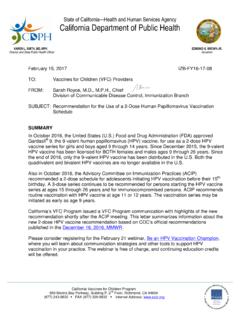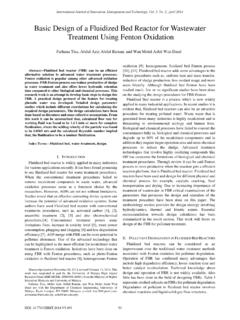Transcription of HYDROGEN SULFIDE: HUMAN HEALTH ASPECTS - who.int
1 This report contains the collective views of an international group of experts and does notnecessarily represent the decisions or the stated policy of the United Nations EnvironmentProgramme, the International Labour Organization, or the World HEALTH International Chemical Assessment Document 53 HYDROGEN SULFIDE: HUMAN HEALTH ASPECTSP lease note that the layout and pagination of this pdf file are not necessarilyidentical to those of the printed CICADF irst draft prepared by Dr Selene J. Chou, Agency for Toxic Substances and DiseaseRegistry, Atlanta, Georgia, USAP ublished under the joint sponsorship of the United Nations Environment Programme, theInternational Labour Organization, and the World HEALTH Organization, and produced withinthe framework of the Inter-Organization Programme for the Sound Management HEALTH OrganizationGeneva, 2003 The International Programme on Chemical Safety (IPCS), established in 1980, is a jointventure of the United Nations Environment Programme (UNEP), the International LabourOrganization (ILO), and the World HEALTH Organization (WHO).
2 The overall objectives of the IPCSare to establish the scientific basis for assessment of the risk to HUMAN HEALTH and the environmentfrom exposure to chemicals, through international peer review processes, as a prerequisite for thepromotion of chemical safety, and to provide technical assistance in strengthening national capacitiesfor the sound management of Inter-Organization Programme for the Sound Management of Chemicals (IOMC) wasestablished in 1995 by UNEP, ILO, the Food and Agriculture Organization of the United Nations,WHO, the United Nations Industrial Development Organization, the United Nations Institute forTraining and Research, and the Organisation for Economic Co-operation and Development(Participating Organizations), following recommendations made by the 1992 UN Conference onEnvironment and Development to strengthen cooperation and increase coordination in the field ofchemical safety.
3 The purpose of the IOMC is to promote coordination of the policies and activitiespursued by the Participating Organizations, jointly or separately, to achieve the sound management ofchemicals in relation to HUMAN HEALTH and the Library Cataloguing-in-Publication DataHydrogen sulfide : HUMAN HEALTH ASPECTS .(Concise international chemical assessment document ; 53) sulfide - adverse effects sulfide - toxicity exposure Programme on Chemical Safety 92 4 153053 7 (LC/NLM Classification: QV 662) ISSN 1020-6167 World HEALTH Organization 2003 All rights reserved. Publications of the World HEALTH Organization can be obtained fromMarketing and Dissemination, World HEALTH Organization, 20 Avenue Appia, 1211 Geneva 27,Switzerland (tel: +41 22 791 2476; fax: +41 22 791 4857; email: Requests forpermission to reproduce or translate WHO publications whether for sale or for noncommercialdistribution should be addressed to Publications, at the above address (fax: +41 22 791 4806.))
4 Email: designations employed and the presentation of the material in this publication do not implythe expression of any opinion whatsoever on the part of the World HEALTH Organization concerningthe legal status of any country, territory, city or area or of its authorities, or concerning thedelimitation of its frontiers or boundaries. Dotted lines on maps represent approximate border lines forwhich there may not yet be full mention of specific companies or of certain manufacturers products does not imply that theyare endorsed or recommended by the World HEALTH Organization in preference to others of a similarnature that are not mentioned. Errors and omissions excepted, the names of proprietary products aredistinguished by initial capital World HEALTH Organization does not warrant that the information contained in thispublication is complete and correct and shall not be liable for any damages incurred as a result of Federal Ministry for the Environment, Nature Conservation and Nuclear Safety, Germany,provided financial support for the printing of this by Wissenschaftliche Verlagsgesellschaft mbH, D-70009 Stuttgart 10iiiTABLE OF CONTENTSFOREWORD.
5 SUMMARY .. 42. IDENTITY AND PHYSICAL/CHEMICAL PROPERTIES .. 53. ANALYTICAL METHODS .. 54. SOURCES OF HUMAN AND ENVIRONMENTAL EXPOSURE .. 65. ENVIRONMENTAL TRANSPORT, DISTRIBUTION, AND LEVELS AND HUMAN EXPOSURE .. KINETICS AND METABOLISM IN LABORATORY ANIMALS ANDHUMANS .. ON LABORATORY MAMMALS AND IN VITRO TEST exposure .. Short-term exposure .. Medium-term exposure .. exposure and carcinogenicity .. and related toxicity .. Effects on Developmental toxicity .. of action .. ON effects .. effects .. effects .. effects .. effects .. 1810. EVALUATION OF HEALTH EFFECTS .. Hazard identification and dose response assessment .. Criteria for setting tolerable concentrations for HYDROGEN Sample risk characterization.
6 Uncertainties in the evaluation of HEALTH risks .. 2011. PREVIOUS EVALUATIONS BY INTERNATIONAL 21 Concise International Chemical Assessment Document 53ivREFERENCES .. 22 APPENDIX 1 SOURCE 27 APPENDIX 2 CICAD PEER REVIEW .. 27 APPENDIX 3 CICAD FINAL REVIEW BOARD .. 28 APPENDIX 4 ABBREVIATIONS AND 29 APPENDIX 5 GLOSSARY .. 29 INTERNATIONAL CHEMICAL SAFETY CARD .. D ORIENTATION .. 32 RESUMEN DE ORIENTACI N .. 34 HYDROGEN sulfide: HUMAN HEALTH aspects1 FOREWORDC oncise International Chemical AssessmentDocuments (CICADs) are the latest in a family ofpublications from the International Programme onChemical Safety (IPCS) a cooperative programme ofthe World HEALTH Organization (WHO), the InternationalLabour Organization (ILO), and the United NationsEnvironment Programme (UNEP).
7 CICADs join theEnvironmental HEALTH Criteria documents (EHCs) asauthoritative documents on the risk assessment Chemical Safety Cards on therelevant chemical(s) are attached at the end of theCICAD, to provide the reader with concise informationon the protection of HUMAN HEALTH and on emergencyaction. They are produced in a separate peer-reviewedprocedure at IPCS. They may be complemented byinformation from IPCS Poison Information Monographs(PIM), similarly produced separately from the are concise documents that provide sum-maries of the relevant scientific information concerningthe potential effects of chemicals upon HUMAN healthand/or the environment. They are based on selectednational or regional evaluation documents or on existingEHCs. Before acceptance for publication as CICADs byIPCS, these documents undergo extensive peer reviewby internationally selected experts to ensure their com-pleteness, accuracy in the way in which the original dataare represented, and the validity of the primary objective of CICADs is characteri-zation of hazard and dose response from exposure to achemical.
8 CICADs are not a summary of all availabledata on a particular chemical; rather, they include onlythat information considered critical for characterizationof the risk posed by the chemical. The critical studiesare, however, presented in sufficient detail to support theconclusions drawn. For additional information, thereader should consult the identified source documentsupon which the CICAD has been to HUMAN HEALTH and the environment willvary considerably depending upon the type and extent ofexposure. Responsible authorities are strongly encour-aged to characterize risk on the basis of locally measuredor predicted exposure scenarios. To assist the reader,examples of exposure estimation and risk characteriza-tion are provided in CICADs, whenever possible. Theseexamples cannot be considered as representing allpossible exposure situations, but are provided asguidance only.
9 The reader is referred to EHC every effort is made to ensure that CICAD srepresent the current status of knowledge, new informa-tion is being developed constantly. Unless otherwisestated, CICADs are based on a search of the scientificliterature to the date shown in the executive summary. Inthe event that a reader becomes aware of new informa-tion that would change the conclusions drawn in aCICAD, the reader is requested to contact IPCS toinform it of the new flow chart on page 2 shows the proceduresfollowed to produce a CICAD. These procedures aredesigned to take advantage of the expertise that existsaround the world expertise that is required to producethe high-quality evaluations of toxicological, exposure,and other data that are necessary for assessing risks tohuman HEALTH and/or the environment.
10 The IPCS RiskAssessment Steering Group advises the Coordinator,IPCS, on the selection of chemicals for an IPCS riskassessment based on the following criteria: there is the probability of exposure; and/or there is significant , it is typical of a priority chemical that it is of transboundary concern; it is of concern to a range of countries (developed,developing, and those with economies in transition)for possible risk management; there is significant international trade; it has high production volume; it has dispersive Steering Group will also advise IPCS on the appro-priate form of the document ( , EHC or CICAD) andwhich institution bears the responsibility of the docu-ment production, as well as on the type and extent of theinternational peer first draft is based on an existing national,regional, or international review.
















